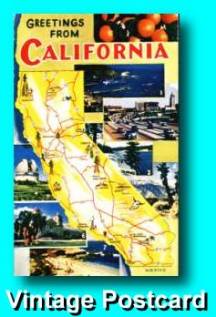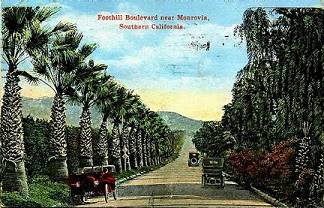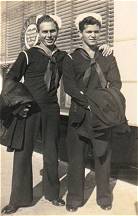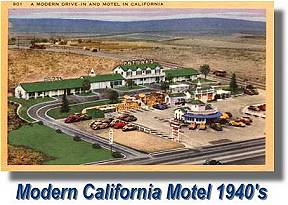|
California
|
|
|
California
|
|
Go to Route 66 State: |
 |
Golden Shores of California - West End of Route 66From the earliest times California beckoned to the adventurous in spirit. The fur trade, the fertile farms and ranches, the hills full of gold and the abundant resources of a new land enticed a nation. California was the jewel of our collective United States. Route 66 opened the way to the "Promised Land." California’s Route 66 became a highway of dreams. It crossed the dreaded Mojave Desert and overlooked the fertile valley of San Bernardino, gateway to Los Angeles and the Pacific. It became the stuff of legend and stories. For over a hundred years the old trails had been leading the way to California. Now on the paths forged by early explorers Route 66 provided the way west. Route 66 became the southern route to California. It wound its way through the countryside, and through the small towns of America. With it came the economic possibilities of the tourist trade, the automobile service industry, and exchange of goods along a vast network of highways. Route 66 brought the cultures of a vast and diverse land together as one people, as one nation. |
| With Route 66 the romantic far western shores of California were now open for a nation yearning to travel. The tourist industry began to flourish in these early years. At that time the services we take for granted today were far and few between. Early on the road was seen as providing an economic boost to the towns it passed through. The new tourist industry that serviced the highway traveler would help dispel the hardship of the dark days to come when our nation was in the grip of a great depression. |  California Seemed like a paradise! |
It has been estimated that 65 percent of America’s westbound traffic, and 50 percent of eastbound traffic followed Route 66 during the 1930s. Travelers during this period were largely dependent on camping for their overnight lodging, particularly across the California desert. There were only a few small auto camps and even fewer hotels along this portion of the route. Those businesses along Route 66 always had a steady stream of customers. The highway actually kept many small towns alive during the Great Depression. The highway continued to represent opportunity in the minds of countless people. |
|
Vintage Post Card of the Santa Monica PierThere has always been something exotic about California. The Santa Monica Pier was already an institution by the time Route 66 arrived some 30 years later. The Santa Monica pier, though not the original end of Route 66 in 1926, came to represent the symbolic western terminus of the Mother Road from the 1940s through 1960s. |
|
|
During the Great Depression of the 1930s, Route 66 became a thoroughfare for thousands of hopeful Midwesterners and southerners on their way to California seeking a better life. The years of 1934 and 1936 were particularly hot and dry in the central portion of the country, and in one dust storm, 300 million tons of topsoil was blown away from Texas, Oklahoma, Arkansas, and Colorado. An estimated 210,000 emigrants came to California during the depression years. The plight of the Oakies became a part of the Route 66 story, the legend of the road. | |||
| John Steinbeck wrote of the dust bowl immigrants in his controversial book "The Grapes of Wrath" in 1939. No one knew of the impact this story would have on Route 66 when it first came out. It established the mythical Joad family in the American psyche, connecting them with the highway itself. It chronicled a vast migration along a road of flight. Steinbeck described Route 66 as "the path of a people in flight, refugees from dust and shrinking land, from the thunder of tractors and shrinking ownership . . . they come into 66 from the tributary side roads, from the wagon tracks and the rutted country roads. 66 is the mother road, the road of flight". |
|
|||
 |
By the time World War Two broke out, Route 66 had already gained a celebrity status. But war would bring yet more changes on Route 66. Route 66 became an important strategic road for the movement of troops and supplies. Air bases, training facilities, and manufacturing centers sprung-up in California. World War Two opened up new worlds to the sailors and soldiers that were stationed in California too. Many of the soldiers and sailors had never been to California before. The pleasant weather and natural beauty impressed them. They would remember California after the war, and many would return. After the war, returning soldiers in particular took to the open road. They took their families to visit places they had seen during the war, visited friends across the country, and looked for work. Many of these travelers came west, and a large number of them stayed. |
| Following the war, Route 66 entered a golden age of tourism, as people were wealthier than ever before, and were able to take vacations. Route 66 became the highway of many a family vacation. "Are we there yet" echoed up and down the old roadway. Travel on Route 66 increased, the tourist industry, which had slowed down during the war, picked up again with full force. America was on the move, and California was the destination. The post war years brought a migration to California even bigger than the dust bowl migration. Some would come to California to stay, and others would bring their families for a vacation. After the war, prosperity allowed thousands of people to follow the road on a truly American tourist adventure. Businesses sprouted up along the route to take advantage of this growing tourist trade. Bright neon signs, curio shops, locally owned cafes, and tourist traps all beckoned the motorist to stop and get out of the car. | ||||
| And Route 66 became a destination unto itself. It was now celebrated as a road of adventure. The highway was so integral to the experience of a mobile society that a song was written in 1946 to commemorate it: "Get Your Kicks on Route 66." In 1946 Bobby Troop,another wartime veteran stationed in California during the war, moved his family to the golden state to pursue a song writing and acting career. With the help of his wife, who gave him the title, and Nat King Cole he wrote his famous song. Since its debut Troop's song has been recorded by almost a hundred artists ranging from Bing Crosby to the Rolling Stones! "Get Your Kicks on Route 66," has become the phrase that says it all when talking about the Mother Road. |
|
|||
 |
Jack D. Rittenhouse had traveled Route 66 several times while working as a advertising copywriter, driving from his home in Los Angeles to Chicago. Rittenhouse realized that after the war, people would be free to travel again, and many would be driving Route 66. In 1946, Rittenhouse wrote a guidebook for the road. With the publication of Robert Troup's song, and Rittenhouse's guidebook, the highway became a tourist phenomenon. | |||
|
The Adventure in the JourneyI've had this post card for forty years, my dad sent it to me when he went to California for a new job. We were getting ready to move there from Denver in 1961. Guess what road we used to get there! |
Detailed Vintage Maps of Route 66 in California: [Los Angeles 1955] [Pasadena 1955] [Foothill Blvd 1955] [1960 California Road Map] |
Click on an area or city of Route 66 on the map below to take a cyber tour of that section of the Mother Road |
| NAVIGATION NOTE: Buckle up and hold on to your mouse! These pages are arranged like the map above, Pacific Ocean being West Route 66 and the Colorado River East Route 66. I have set up this site as if you were traveling from EAST to WEST, much like the Joad family in The Grapes of Wrath. You can click on the Route 66 shields to "travel" the Mother Road in either direction though. Or you can select any shield below to take you to that specific state. | ||
To Santa Monica |
To the Colorado River |
© Copyright 2003 GRandall Web Design Service